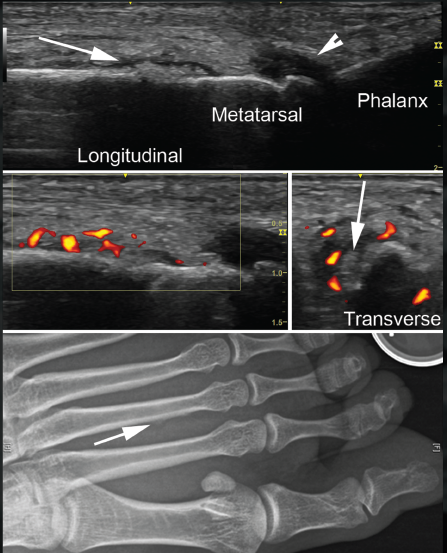Presentation
A 30-year-old woman presented to her rheumatologist for left foot pain of three weeks’ duration. She was followed for systemic lupus erythematosus manifesting in arthritis and hemolytic anemia, as well as anti-nuclear antibody and Smith antibody positivity, and was treated with hydroxychloroquine and prednisone in the 2.5–10 mg per day range. She was symptom free for six months prior to the development of her foot pain and had tapered off prednisone six weeks prior to her visit. Every day for the previous month, she had walked a mile to the hospital for her sick child. Her foot pain was much worse with weight bearing, but she had no other symptoms of disease. Her examination revealed normal vital signs and localized tenderness over the third metatarsal.
The Ultrasound
Panel “a” in the figure above shows a longitudinal ultrasound image of the dorsal aspect of the third metatarsal, with hazy, hyperechoic material over the metatarsal shaft, outlined by an anechoic lining. This appearance is produced by periosteal elevation and edema. The arrow head points to synovial tissue of the metatarsal joint, which was neither tender to sonopalpation, nor hyperemic on Doppler imaging.
Panels “b” and “c” demonstrate hyperemia surrounding the periosteum on longitudinal and transverse Doppler imaging, but not the joint synovium.
 Panel “d” depicts a radiograph of the foot, with an arrow pointing to the barely visible elevated periosteum, corresponding to the region of stress fracture.
Panel “d” depicts a radiograph of the foot, with an arrow pointing to the barely visible elevated periosteum, corresponding to the region of stress fracture.
Treatment & Discussion
The patient was treated with a walking boot, and her symptoms resolved. Ultrasound can demonstrate superficial bone lesions involving the periosteum, including stress fractures, and may be able to detect such lesions more easily than pain film radiography, although this question has not yet been systematically evaluated.1
One study published last year did find that emergency medicine residents were better able to identify long bone fractures using ultrasound than with X-ray (accurate identification mean proportion 0.89 vs. 0.75, respectively [P<0.001]). This difference was more pronounced as the level of ultrasound and emergency department experience increased.2
Stress fractures are more likely to occur in patients with rheumatic conditions, not only due to a predisposition to osteoporosis from the condition itself, but often due to concomitant treatment with glucocorticoids. Stress fractures of the tibia, metatarsals and fibula are the most frequently reported.3
The authors are mentors for USSONAR, a society of rheumatologists, physicians and health professionals working to promote the use of musculoskeletal ultrasonography to advance the care of patients with rheumatic diseases. Learn more.
Discover
The ACR offers an RhMSUS certification program. Learn more.
